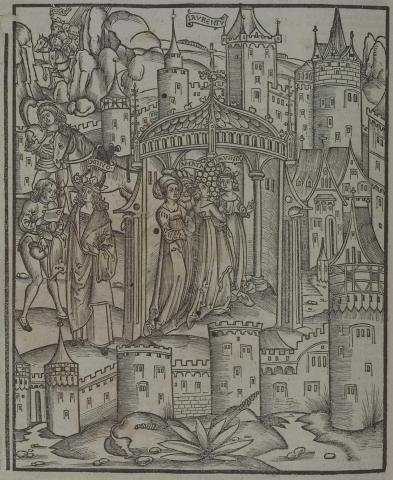Annotations
In the top left corner, Aeneas rides toward the battlefield (446). Below this, a messenger gives a message to Latinus that the Trojans approach the battlefield prepared for battle (447-50). A messenger would not usually carry this kind of message in a written form, but the presence of a letter in the messenger's hand helps to identify the figure. Latinus is visibly saddened by this news, because he still strongly desires peace (469-73). Behind Latinus, a Latin soldier arms for battle (453-4). In the center of the image, Amata has brought Lavinia and several mothers from the city to the temple of Pallas Athena, portrayed here as a small round temple. With the help of the women, she prays to the goddess to let Turnus kill Aeneas (477-85). The city walls are prominent in this image, emphasizing that all the actions take place within the city, and that all actions within the city are preparing to defend it.
Woodcut illustration from the “Strasbourg Vergil,” edited by Sebastian Brant: Publii Virgilii Maronis Opera cum quinque vulgatis commentariis expolitissimisque figuris atque imaginibus nuper per Sebastianum Brant superadditis (Strasbourg: Johannis Grieninger, 1502), fol. 381v, executed by an anonymous engraver under the direction of Brant.


Sebastian Brant (1458-1521) was a humanist scholar of many competencies. Trained in classics and law at the University of Basel, Brant later lectured in jurisprudence there and practiced law in his native city of Strasbourg. While his satirical poem Das Narrenschiff won him considerable standing as a writer, his role in the transmission of Virgil to the Renaissance was at least as important. In 1502 he and Strasbourg printer Johannes Grüninger produced a major edition of Virgil’s works, along with Donatus’ Life and the commentaries of Servius, Landino, and Calderini, with more than two hundred woodcut illustrations. (Annabel Patterson)